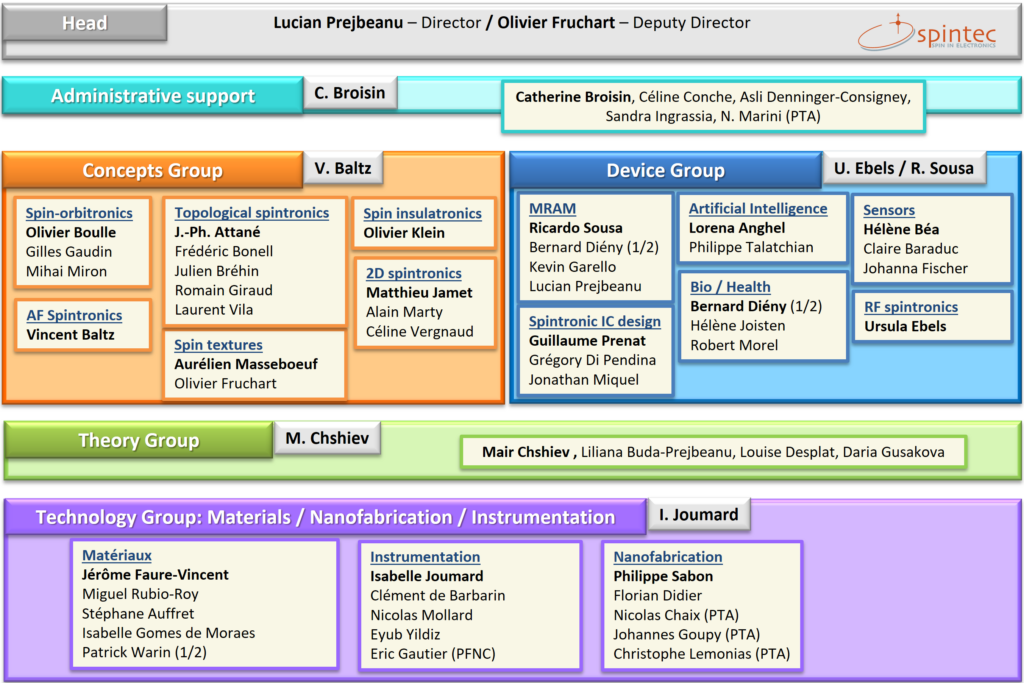The laboratory is managed an executive director (Lucian Prejbeanu) and a deputy director (Olivier Fruchart). Research activities are organized in three research groups (theory, devices and concepts) and , each composed of smaller teams dealing with a focused topic. Support to research is provided by highly-skilled engineers and technicians gathered in a technological group, with three teams: materials synthesis, nanofabrication and instrumentation. The executive board of SPINTEC includes the two directors, the four group leaders, and the administrative manager Catherine Broisin.
Lucian PREJBEANU, Executive Director
 Lucian Prejbeanu has been conducting research on nanomagnetism and spintronics for more than 15 years. He holds a Physics degree from Babes Bolyai University in Cluj (Romania) and a PhD in Physics from Louis Pasteur University in Strasbourg where he pioneered the work on magnetic nanostructures. He then joined SPINTEC research laboratory in Grenoble, where he pioneered scientific work on thermally assisted MRAM, tackling the key long-standing problem of bits stable enough for long-term storage, yet still easy to write with small magnetic fields. Based on this proof-of-principle of the scientific concepts, Crocus Technology was founded in 2006 to develop and commercialize thermally assisted MRAM technology. Lucian joined Crocus Technology mid-2006 as R&D manager, where he made key contributions to the development and industrialization of thermally assisted MRAM for which he was awarded the SEE-IEEE Brillouin prize in 2012. In 2013, Lucian returns to Spintec as deputy director and became executive director as of January 1st, 2016. He holds 38 international patents on magnetic memories and has authored more than 70 scientific publications and book chapters on nanomagnetism and spintronics.
Lucian Prejbeanu has been conducting research on nanomagnetism and spintronics for more than 15 years. He holds a Physics degree from Babes Bolyai University in Cluj (Romania) and a PhD in Physics from Louis Pasteur University in Strasbourg where he pioneered the work on magnetic nanostructures. He then joined SPINTEC research laboratory in Grenoble, where he pioneered scientific work on thermally assisted MRAM, tackling the key long-standing problem of bits stable enough for long-term storage, yet still easy to write with small magnetic fields. Based on this proof-of-principle of the scientific concepts, Crocus Technology was founded in 2006 to develop and commercialize thermally assisted MRAM technology. Lucian joined Crocus Technology mid-2006 as R&D manager, where he made key contributions to the development and industrialization of thermally assisted MRAM for which he was awarded the SEE-IEEE Brillouin prize in 2012. In 2013, Lucian returns to Spintec as deputy director and became executive director as of January 1st, 2016. He holds 38 international patents on magnetic memories and has authored more than 70 scientific publications and book chapters on nanomagnetism and spintronics.
Olivier FRUCHART, Deputy Director
 Olivier Fruchart graduated in Physics from École Normale Supérieure in Paris, then received a PhD from Grenoble University, and conducted most of his later carrier in Grenoble. He has been active in the field of nanomagnetism for twenty years. His early focus was low-dimensional and surface magnetism, with a particular emphasis on self-organized systems. In particular, he developed synthesis processes to turn a two-dimensional organized patterned into an array of pillars, to increase thermal stability. His current research topic is the structure and field- and current-driven motion of magnetic domain walls, with a particular emphasis on the exploration of bottlenecks set by the concept of a three-dimensional race-track memory based on magnetic nanowires and nanotubes. He authored more than 105 publications, plus several reviews, book chapters and editorships. He created and had been managing for two decades the European School on Magnetism. He is currently President of the European Magnetism Association. He joined Spintec in 2016, acting since as deputy director.
Olivier Fruchart graduated in Physics from École Normale Supérieure in Paris, then received a PhD from Grenoble University, and conducted most of his later carrier in Grenoble. He has been active in the field of nanomagnetism for twenty years. His early focus was low-dimensional and surface magnetism, with a particular emphasis on self-organized systems. In particular, he developed synthesis processes to turn a two-dimensional organized patterned into an array of pillars, to increase thermal stability. His current research topic is the structure and field- and current-driven motion of magnetic domain walls, with a particular emphasis on the exploration of bottlenecks set by the concept of a three-dimensional race-track memory based on magnetic nanowires and nanotubes. He authored more than 105 publications, plus several reviews, book chapters and editorships. He created and had been managing for two decades the European School on Magnetism. He is currently President of the European Magnetism Association. He joined Spintec in 2016, acting since as deputy director.
Organization chart of SPINTEC, composed of the management, research organized in three groups and sub-teams, and the technological group, supporting to research. In practice, work is performed cooperatively in a very flexible manner.





